If you were a kid and you went to my grandmother, Maudie’s house in Salem, WV in the 1960s, you’d spend a fair amount of time on your back, on the floor, admiring the under-the-chair art gallery in her “front” room. You wouldn’t have a piece of pie with you, but there’s a good chance that you’d just eaten a slice of apple pie. My Uncle Sonny (Emery) never would tell me the story of why in the heck he drew under the seats of the extra dining room chairs in about 1931. Did he get in trouble? I will never know. Probably not. Anyway, when my grandmother passed away, this particular chair is the only thing of hers I really wanted. The chair wasn’t sturdy enough to stand up to our twins, but I saved the seat bottom and it hangs mischieviously on our wall. That’s the kind of art we have.
Oh yea, there’s a bit of a pie plate emergency discussion I wanted to have with you real quick before the holidays. It turns out that I’m an official pie lady. And, as such, I have strong opinions about pie plates.
If you go shopping for glass pie plates now, you’ll most likely find the clear pyrex 9-inch deep dish pie plate with ridges. You cannot make a normal regular-people pie in this pie plate. It’s big-a-fied and what’ll you’ll likely get is overcooked crust and undercooked starchy innards. These colorful 1950s shallow 9-inch pie plates, pictured above, are my personal favorites because I can match my pie filling to the pie plate. Especially important with a lattice crust, don’t you know. I’ll bake one pumpkin pie in the yellow dish, and one in the green one on Thursday for Thanksgiving. These hold about half as much filling as a deep dish pie and that’s a good thing.
But this is actually a better pie plate for a pumpkin pie. The problem with pumpkin pie is that the guts want to bake at 350 and the crust wants to bake at 400. So the trick to not having a soggy bottomed pumpkin custard pie, is to stick it in the oven on the bottom rack (if gas oven), or next to the bottom rack (electric oven) in a hot 425 oven for about 12 minutes and then turn the oven to 350 and continue to bake. A clear plate lets you look at how the bottom of your crust is faring.
If you spend much time reading old cookbooks like I do, you’ll wonder how Americans kept a trim waistline while eating pie about every day in the 1930s and 40s. Especially in rural areas. This may be true, but they were baking their pies in 8 inch pie plates and sharing those pies between 6 or 8 people. And they walked wherever they were going, and probably spent a fair amount of time tending their farms/gardens/animals.
If you look at these pie plates lined up, you’ll see at the bottom a 6-inch pyrex pie plate, then an 8-inch Fire King, and then a 9-inch Fire King, and then a 10-inch very shallow pyrex for those big families. I adore vintage pie plates like these and they’re easy to find at yard sales and antique booths for under $10. The Fire King Sapphire Blue Philbe was made from the early 40s through the mid 50s and these clear pyrex plates are from the 1950s I’m guessing.
When my sisters and I were kids, my mom would make a regular sized pie for the family, and then she’d make one of these little 6-inch pies for the three little girls to share at their tea party. She gave me the little pie plate and since then, I have amassed/hoarded about 15 more because they are perfect for pie-making classes. They behave just like real pie plates, but I can fit lots of them in the oven at once, the pies cook quickly and then the pies slip out like butter when they are fully baked so they can be taken home by students.
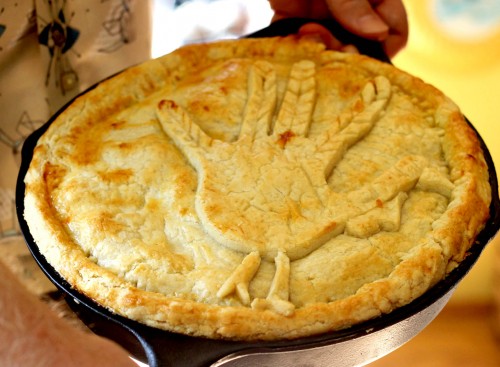
(but I wish it was me, it’s adorable.)
Happy Thanksgiving!
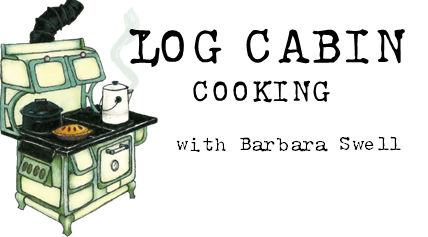
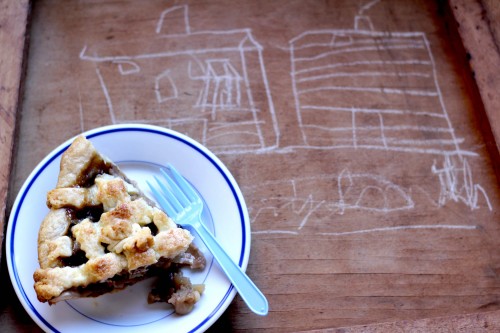
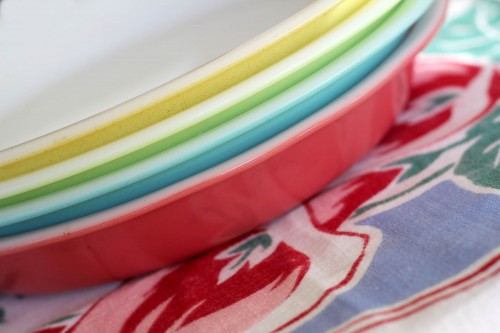
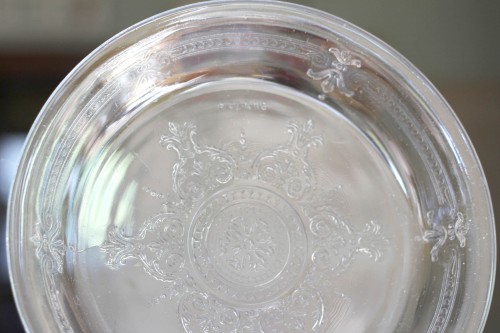
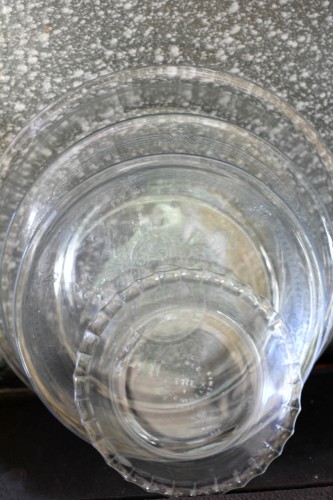
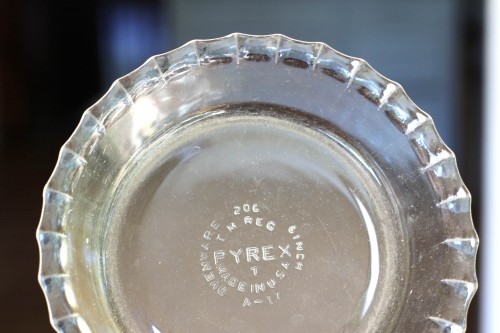
Lovely post! I love all the pie dishes and the pie at the end is so cute! Ive just discovered your blog – love it!
I re-read your pie book yesterday before making pie dough and I corrected some mistakes that I have been making. However, because I used two of those big new glass pie pans, I did have trouble with the baking. I slightly overcooked the (pumpkin) pie crust. It was fine to eat, but darker than I really wanted. Have you ever used a hand thrown ceramic (or commercial–Hartstone Pottery, maybe) ceramic pie baker? I was wondering it they are worth the investment.
Yea for pumpkin pie! I’ve seen lovely pies baked in the hartstone type pottery pie plates, but they’re also very large pie plates and unless you pre-cook your innards (works well with apple) and protect your crust, same deep-dish problem. I’m sticking with shallow glass plates because they work for me and the serving sizes are more reasonable.
Do you have any of the colorful 1950s shallow 9-inch pie plates for sale?
Hi Sarah, I don’t keep extra colorful pie plates, but if you do a search of “pyrex pie plates” on Etsy, you’ll find plenty. You have good taste!!!
You know what, I just hate soggy pie crust, so what I do is “pie on the side”–I just bake up the crust on a cookie sheet and then eat it with the filling on the side–works for me! Not much to look at, but it sure tastes good! And speaking of, has anybody ever tried eating well-cooked sausage patties with fruit pie? It’s so good; try it–be sure to really cook your pork sausage crisp–I imagine bacon would be great, too-after all, what is not good with bacon?!